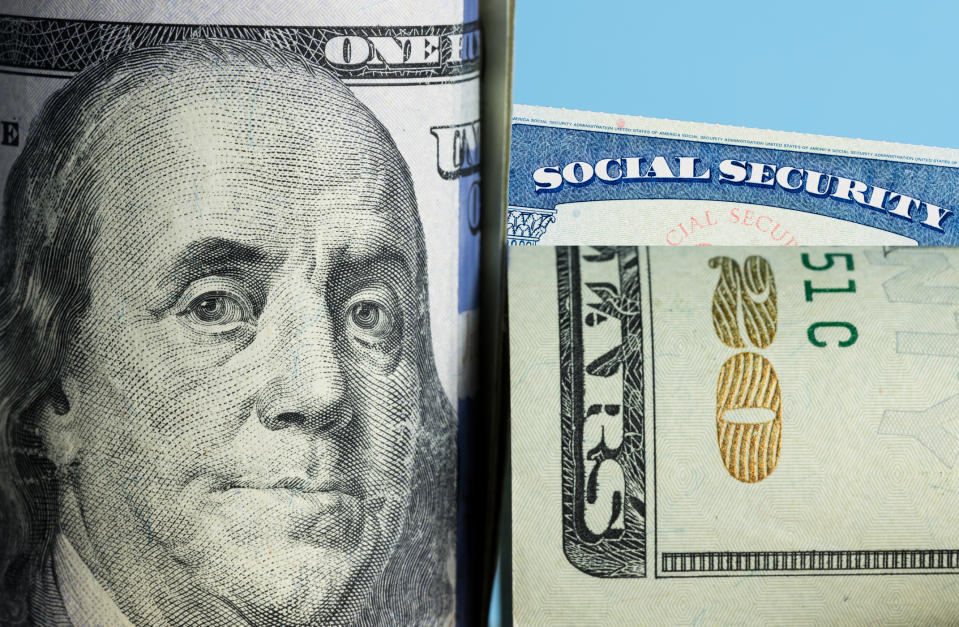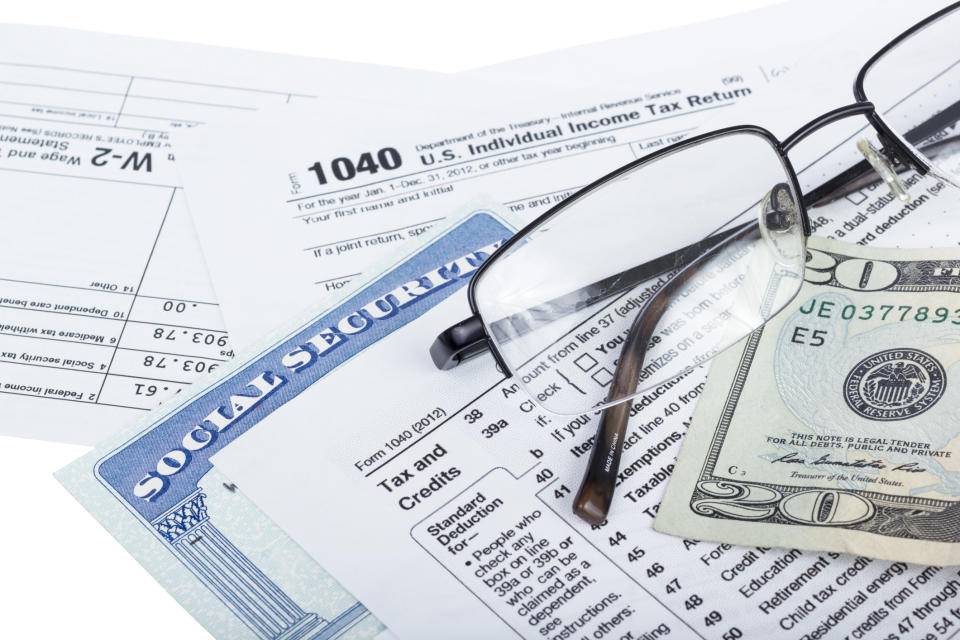55 All-Inclusive Social Security Facts
Social Security is, unquestionably, our nation's most important social program. For nearly eight decades, it's been responsible for providing a financial foundation for tens of millions of Americans.
As incredibly important as Social Security is, it's also largely misunderstood. Back in 2015, MassMutual released an online, 10-question, true-false survey that just 28% of the 1,513 respondents passed (i.e., got seven or more answers correct), including just one individual with a perfect score. This survey focused on basic Social Security concepts that adults of all ages should be familiar with.
In 2018, MassMutual's follow-up true-false survey was released, albeit this one was only five questions and targeted at 1,007 adults aged 50 and over. Even with a focus on preretirees, who you'd think would have a better grasp of Social Security than the broader adult population, 47% failed to answer four or five questions correctly.

Image source: Getty Images.
Everything you need to know about Social Security
With the understanding that knowledge is power when it comes to Social Security, here are 55 all-inclusive facts you should know about our country's most important social program.
1. The Social Security Act was signed into law in the summer of 1935, but the first monthly payout didn't occur until January 1940.
2. Nearly 63 million people are receiving a Social Security benefit each month, including retired workers, survivors of deceased workers, the long-term disabled, and potentially qualifying immediate families in all three categories.
3. An estimated 175 million workers and their families are also covered by long-term disability insurance or survivor's insurance protection.
4. Social Security isn't an entitlement, with most beneficiaries earning their way to a benefit through at least 10 years of work.
5. In order to receive a Social Security retirement benefit, you'll have to earn 40 lifetime work credits, of which a maximum of four can be earned annually. But don't worry, each credit equates to $1,360 in earnings this year, meaning $5,440 in wages will max out your credits for 2019.
6. Of currently retired workers, 62% lean on Social Security to provide at least half of their monthly income.
7. Of the more than 43 million retired workers, 34% rely on the program for 90% to 100% of their income.
8. However, Social Security is only designed to replace about 40% of your working wages, suggesting that it's not to be considered a primary income source.

Image source: Getty Images.
9. The average retired worker was taking home $1,461.31 a month as of December 2018.
10. Even though Social Security won't make the average beneficiary wealthy, it is keeping 22.1 million people out of poverty, according to an analysis from the Centers on Budget and Policy Priorities.
On the rules you'll want to know
11. Social Security benefits for retired workers can begin at age 62, or any point thereafter. However, certain provisions can allow children or adults under the age of 62 to receive benefits.
12. The long-term disabled aren't required to have 40 lifetime work credits to receive benefits. The Social Security Administration has a progressive scale for credit requirements based on age to ensure that younger workers still have an opportunity to qualify for disability benefits.
13. Your full retirement age, or the age at which you're entitled to 100% of your monthly payout, is determined by your birth year. For most baby boomers, your full retirement age will range between 66 and 67 years. For anyone born in 1960 or after, it's age 67.
14. Claiming benefits at any age prior to reaching your full retirement age means accepting a permanent reduction to your monthly payout of up to 30%, depending on your birth year. Conversely, waiting until as late as age 70 to claim benefits could boost your payout by an additional 24% to 32%.
15. The full retirement age will have increased by just two years -- from age 65 to 67 -- between the first payout in 1940 and 2022.

Image source: Getty Images.
16. Retired workers are encouraged to hold off on their filing. Each year a person holds off on taking their benefit between ages 62 and 70, their payout grows by approximately 8%.
17. Roughly three out of five retired workers take their benefit prior to reaching their full retirement age. Conversely, just 10% wait until after their full retirement age to claim their payout.
18. The maximum amount a retired worker can be paid in a month at full retirement age in 2019 is $2,861.
19. The Social Security Administration can withhold some or all of your benefit if you begin taking your payout prior to reaching your full retirement age. The retirement earnings test prevents working Americans in their early to mid-60s from "double-dipping" by earning a working wage and being paid Social Security as well.
20. The retirement earnings test doesn't apply to beneficiaries who've reached their full retirement age.
21. Withheld benefits from the retirement earnings test aren't lost. With the exception of passing away early, you'll get these benefits back in the form of a higher monthly payout upon reaching your full retirement age.
22. Social Security has a built-in do-over clause known as Form SSA-521. Should you regret taking benefits early, you can file Form SSA-521 and request your benefit application be undone within 12 months of first receiving benefits. If approved, you merely have to repay the benefits you've received, and your benefit can grow at roughly 8% per year once again.
23. In rare instances, people who've never worked before can receive a benefit. An example would be a spouse or ex-spouse of a primary or deceased worker.

Image source: Getty Images.
On Social Security's cost-of-living adjustment
24. The Consumer Price Index for Urban Wage Earners and Clerical Workers (CPI-W) is the inflationary tether that determines the program's annual cost-of-living adjustments, or COLA.
25. The average CPI-W reading from the third quarter (July through September) of the previous year acts as the baseline, while the average CPI-W reading from the third quarter of the current year is the comparison. The other nine months simply don't matter for Social Security's COLA calculation.
26. Since CPI-W data for a previous month is released by the Bureau of Labor Statistics in the second week of the current month, Social Security's COLA is always announced during the second week of October.
27. There are eight major spending categories, and dozens upon dozens of subcategories, that go into determining the CPI-W.
28. COLA has been positive in all but three years (2010, 2011, and 2016) since it was introduced in 1975.
29. In years in which the average third-quarter CPI-W reading drops year over year, payouts remain static. Thankfully, benefits cannot decline due to inflation.
30. Social Security's purchasing power has fallen an estimated 34% between January 2000 and January 2018, according to The Senior Citizens League. Place the blame for this on the CPI-W not adequately taking seniors' expenses into its weighting formula.
31. Not all beneficiaries will necessarily receive a COLA in a given year as a result of the hold-harmless clause.

Image source: Getty Images.
On how Social Security collects revenue
32. Social Security has just shy of $2.9 trillion in its asset reserves. These "asset reserves" are a fancy way of describing its aggregate net cash surpluses each year.
33. The program's asset reserves are required by law to be invested in special-issue federal bonds and, to a lesser extent, certificates of indebtedness. As of Dec. 31, 2018, these special-issue assets were yielding an average of 2.85%.
34. The interest income from Social Security's asset reserves generated $85.1 billion for the program in 2017, and it is expected to bring in just over $800 billion between 2018 and 2027.
35. The program's workhorse, in terms of revenue generation, is the 12.4% payroll tax on earned income. The payroll tax led to $873.6 billion of the $996.6 billion collected in 2017.
36. Most workers aren't responsible for the full 12.4% payroll tax, with employers and employees splitting this liability down the middle at 6.2%. Only the self-employed pay the full amount (12.4%).
37. Payroll tax is applied to all earned income ranging between $0.01 and $132,900, as of 2019. This upper "cap" is adjusted annually in step with the National Average Wage Index, and it exists because of the aforementioned cap on the maximum monthly benefit at full retirement age.
38. More than 9 out of 10 workers will earn less than $132,900 in 2019, thereby paying tax into the program on every dollar they earn.
39. Earned income above $132,900 in 2019 is exempted from the payroll tax. The amount exempted has quadrupled from $300 billion in 1984 to $1.2 trillion as of 2016.

Image source: Getty Images.
40. Social Security benefits may also be taxable. In 2017, the taxation of benefits generated $37.9 billion in revenue. However, this figure will more than double over the next decade.
41. If an individual taxpayer's adjusted gross income (AGI) plus one-half of their benefits exceeds $25,000 (or $32,000 for married couples filing jointly), they'll face federal income tax on 50% of their Social Security benefits.
42. A second tier of taxation on Social Security benefits was introduced in 1993, allowing 85% of Social Security benefits to be taxed if AGI plus one-half of benefits exceeds $34,000 for single taxpayers and $44,000 for couples filing jointly.
43. These income thresholds tied to the taxation of benefits have never been adjusted for inflation.
44. A study from The Senior Citizens League finds that 56% of senior households owe some federal tax on their Social Security benefits.
45. Thirteen states also tax Social Security benefits to some varying degree.
On the future of Social Security
46. The annually published Trustees report is forecasting that Social Security will completely deplete its almost $2.9 trillion in asset reserves by 2034.
47. In addition to the ongoing retirement of baby boomers, increased longevity, growing income inequality, and low fertility rates are to blame for Social Security's woes.
48. Social Security can't go bankrupt, thanks to its recurring revenue from the payroll tax and the taxation of benefits. However, an across-the-board benefit cut of up to 21% may await if Congress doesn't fix the program.

Image source: Getty Images.
49. The Trustees report pegs the program's long-term (75-year) actuarial deficit at 2.84%. That's to say, if payroll taxes were increased by 2.84% today to 15.24% (12.4% + 2.84%), the program would not have to reduce benefits through 2092, and it would end 2092 with enough money in asset reserves to completely cover a full year of payouts to beneficiaries.
50. Social Security is estimated to be facing a $13.2 trillion cash shortfall between 2034 and 2092. The longer Congress waits to act, the larger this shortfall becomes.
51. The last major overhaul of Social Security occurred in 1983. The bipartisan amendments during the Reagan administration led to additional revenue via the introduction of the taxation of benefits and the gradual increase of the payroll tax rate. It also reduced expenditures as a result of the gradual increase in the full retirement age.
52. The most popular Social Security fix among the public would be to raise or eliminate the earnings tax cap associated with the payroll tax.
53. In order to amend the program, 60 votes of support would be needed in the Senate. It's been four decades since either the Democrats or Republicans had a supermajority, suggesting that bipartisan support for an amendment is a must.
54. Democrats favor lifting or eliminating the payroll tax cap. Comparatively, Republicans prefer a gradual increase to the full retirement age. Finding a middle ground between these ideas has proven elusive.
55. Despite its problems, Social Security is one of the most cost-efficient programs, with more than 99% of revenue generated winding up in the hands of eligible beneficiaries.
More From The Motley Fool
The Motley Fool has a disclosure policy.

 Yahoo Finance
Yahoo Finance 